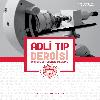Case report: The evaluation of a complex medico-legal case with syncope, diffuse subcutaneous emphsema, bilateral pneumothorax, and eustachian valve
Senkop, yaygın subkutan amfizem, bilateral pnömotoraks ve östakian valf bulunan karmaşık bir mediko-legal olgunun değerlendirilmesi: Olgu sunumu
___
- 1.Knight B. Simpson's Forensic Medicine. 10th Edition. Edward Arnold Press, 1997, London: 8-11.
- 2.Ozgenc I. Explanatory Turkish Penal Codes. Seçkin Publishing House, 2004, Ankara: 391. (Turkish Publication)
- 3.Bilge Y, Gündoğmuş ÜN, Gunduz T, Hanci IH, Katkici U, Kok AN, Yavuz IC, İstanbul Chambers of Doctors. Legal Responsibility of Medical Doctors in Forensic Medicine for First Step (Edited by Istanbul Chambers of Practitioners & Association of Forensic Medicine Specialists). Turkish Medical Association Press, 1999, Ankara: 5-8. (Turkish Publication)
- 4.Na SJ, Lee SI, Chung TS, Choi YC, Lee KY. Pneumomediastinum due to intractable hiccup as the presenting symptom of multiple sclerosis. Yonsei Med J. 2005 Apr 30;46(2):292-5 (Abstract).
- 5.Cavuslu S, Oncul O, Gungor A, Kizilkaya E, Candan H. A case of recurrent subcutaneous emphysema as a complication of endotracheal intubation. Ear, Nose & Throat Journal, 2004 Jul;83(7): 485-8.
- 6.Kaneko Y, Nakazawa K, Yokoyama K, Ishikawa S, Uchida T, Takahashi M, Tsunoda A, Makita K. Subcutaneous emphysema and pneumomediastinum after translaryngeal intubation: tracheal perforation due to unsuccessful fiberoptic tracheal intubation.J Clin Anesth. 2006 Mar;18(2): 135-7.
- 7.Stewart RD, Paris PM, Winter PM, Pelton GH, Cannon GM. Field endotracheal intubation by paramedical personnel. Success rates and complications. Chest 1984;85:341 - 5.
- 8.Chortkoff BS, Perlman B, Cohen NH. Delayed pneumothorax following difficult tracheal intubation. Anesthesiology 1992;77:1225-7.
- 9.Taryle DA, Chandler JE, Good Jr JT, Potts DE, Sahn SA. Emergency room intubations-complications and survival. Chest 1979;75:541-3.
- 10.Evagelopoulos N, Tossios P, Wanke W, Krian A. Tracheobronchial rupture after emergency intubation. Thorac Cardiovasc Surg 1999; 47:395-7.
- 11.Kaloud H, Smolle-Juettner F, Prause G, List W. latrogenic ruptures of the tracheobronchial tree. Chest 1997;112:774 - 8.
- 12.Hoffman HS, Rettig G, Radke J, Neef H, Silber RE. latrogenic ruptures of the tracheobronchial tree. Eur J Cardiothorac Surg 2002; 21:649-52.
- 13.Borasio P, Francesco A, Chiampo G. Post-intubation tracheal rupture: a report on ten cases. Eur J Cardiothorac Surg 1997;12:98-100.
- 14.Sivalingam P, Tio R. Tension pneumothorax, pneumomediastinum, pneumoperitoneum, and subcutaneous emphysema in a 15-year-old Chinese girl after a double-lumen tube intubation and one-lung ventilation. J Cardiothorac Vasc Anesth 1999; 13:312-5.
- 15.Chen JD, Shanmuganathan K, Mirvis SE, Killeen KL, Dutton RP. Using CT to diagnose tracheal rupture. AJR Am J Roentgenol. 2001 May;176(5):1273-80.
- 16.Asirdizer M., Tatlisumak E. The role of eustachian valve and patent foramen ovale in sudden death. J Clin Forensic Med. 2006 Jan 24; [Epub ahead of print]
- 17.Olgin JE, Kalman JM, Fitzpatrick AR Lesh MD. Role of right atrial endocardial structures as barriers to conduction during human type I atriai flutter: activation and entrainment mapping guided by intracardiac echocardiography. Circulation. 1995; 92{7):1839-48.
- 18.Nakagawa H, Lazzara R, KhastgirT, Beckman KJ, McClelland JH, Imai S, Pitha JV, Becker AE, Arruda M, Gonzales MD, Widman LE, Rome M, Neuhauser J, Wang X, Calame JD, Goudeau MD, Jackman WM. Role of the tricuspid annulus and the eustachian valve/ridge on atriai flutter: relevance to catheter ablation of the septal İsthmus and a new technique for rapid identification of ablation success. Circulation. 1996; 94(3):407-24.
- 19.Obel OA, Camm AJ. Supraventricular tachycardia. ECG diagnosis and anatomy. Eur Heart J. 1998;19 Suppl E:E13-24, E50-1.
- ISSN: 1018-5275
- Yayın Aralığı: 3
- Başlangıç: 1985
- Yayıncı: BAYT Yayıncılık
Yıldıray ZEYFEOĞLU, Ertuğrul TATLISUMAK, Mahmut ASIRDIZER, M.Sunay YAVUZ
Piperazin türevlerinin kötüye kullanımı
Faruk AŞICIOĞLU, Ahmet BELCE, Pınar Y. ÇELİK
Giysilerdeki ve ayakkabılardaki topraktan elde edilen polenlerin adli bilimlerde kullanılması
Necmi ÇEKİN, Sadık TOPRAK, Esamil SAYLAK, Mustafa ARSLAN
